#CardboardCreatures
Explore tagged Tumblr posts
Text
Youth Art Month 2020 5/6 Artists
Youth Art Month 2020 5/6 Artists
“The greater danger for most of us lies not in setting our aim too high and falling short; but in setting our aim too low, and achieving our mark.” – Michelangelo
It is my pleasure to announce the artworks and artists for this year’s Boston Youth Art Month show!

Top l to r: Brynn DiAnni, Molly Dishington, Connor Downing Bottom l to r: Andrew Brown, Kaycie Gardner, Jayden Lilburn, Ella Martin, Owen…
View On WordPress
#3Dprinting#artsed#artshow#CardboardCreatures#collaboration#creativity#digitalart#iPadsinart#ipadsinarteducation#MAEA#youthartmonth
0 notes
Text
Not good enough | iPhone Wallpapers
Not good enough | iPhone Wallpapers
[ad_1]
Not good enough
[ad_2] View Reddit by cardboardcreature – View Source
View On WordPress
#iphone wallpaper 4k#iphone wallpaper fall#iphone wallpaper hd original#iphone wallpaper high quality#iphone wallpaper pinterest#iphone wallpaper quotes#iphone wallpaper tumblr#iPhone Wallpapers#top iphone wallpapers
0 notes
Note
well this compliment isn't going to be at all creepy but i like your blog a lot and you clearly have a great taste in shows and humor :D also, the banner at the top of your layout is magnificent.
haha i don't even care that it isn't creepy I ACCEPT!!!!!!!! :P THANK YOU SO MUCH :D
1 note
·
View note
Text
cardboardcreatures replied to your photo: Statistics for retakes in the IB. WELL HOW...
wait i’m so confused though. what exactly does “diploma and retake candidates” mean?
It means they're eligible to retake the exams. (I assume it means they failed at least one class.)
1 note
·
View note
Text
“The most sophisticated people I know – inside they are all children.” – Jim Henson
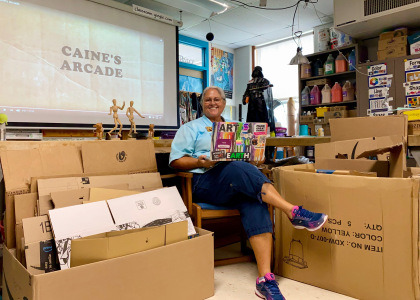
The photo above is of me and a whole bunch of cardboard on October 8, 2019 as I waited to introduce our Cardboard Creature project to an incoming class. It was all down hill from there!
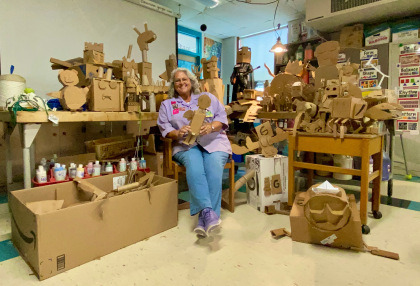
Here’s how we did it:
I introduced this unit by showing Caine’s Arcade, a film by Nirvan Mullick. I’ve been showing this video to students for years, but this is the first time we’ve followed it up by working with cardboard. And I’m so glad we did!
Students started by responding to a bell ringer prompt in their sketchbooks: Design a figure you could make 3D. This prompt is purposely vague and open-ended, allowing for creativity and active imagination. It also initiates first consideration of thinking in 3D. This was a great opportunity to differentiate between creative drawing and scientific diagrams, although they both require creative thinking. These are a couple of the responses:
After sharing designs with the students at their table, groups were formed by students based on friendship, like-mindedness, and similarity of creature design. I encouraged groups of three, and when necessary due to class size, groups of two or four were formed. During their first group meeting, students compared designs and discussed possibilities for a design that either combined individual drawings or elaborated on one of the drawings.
Together we also looked at the cardboard artwork of artist Justin King:
Cardboard Animals By Justin King
And after a couple of classes as an inspiration boost, we also looked at the work of Monami Ohno:
Cardboard Sculptures By Monami Ohno
I also shared these three attachment attachments with the students through Google Classroom. We went over the various ways to construct 3D forms with cardboard so it becomes a mechanical endeavor, well thought out and conceived for prime support and bonding.
Students then began the design process with one person sketching for each group. I asked students to show me their plan for mobility for the figure and for attachments.
This went very well. Clearly there is no shortage of imagination in the 5/6 art classes! Here is a slideshow of some of the group drawings:
This slideshow requires JavaScript.
The Creative Constraints for this project were:
Attachments must be made with attachment techniques and hot glue
Creatures must be self supporting and have mobility
Finished creature width and depth must fit within the designated box
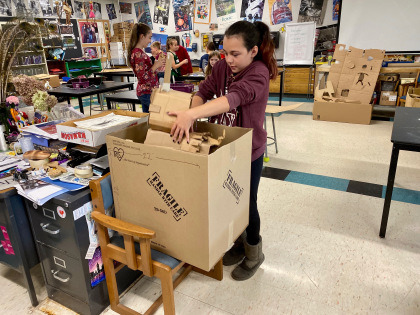
Checking the size of the creature against the designated “size checker” box
Groups were able to start building as soon as their design was approved by me. We were using Canary Cardboard cutters and scissors, glue guns, yarn, and brass fasteners. No tape. We discovered along the way that fishing line was helpful for Phase Two: Stop Motion/Green Screen (shared in a separate post). A couple of groups also used sand for ballast on top-heavy models.
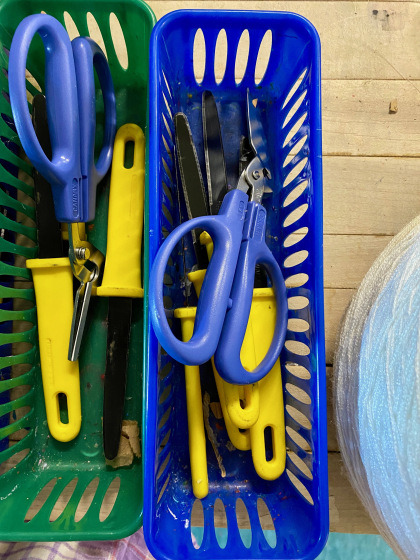

The cutters were arranged in little “toolkits” with 4 cutters and one scissor in each, enough for one toolkit at each table. At the end of every class students returned the tool kits and the glue guns (also one per table) to the supply table. I took a quick inventory to make sure they were all accounted for as I didn’t want these tools to leave the classroom.
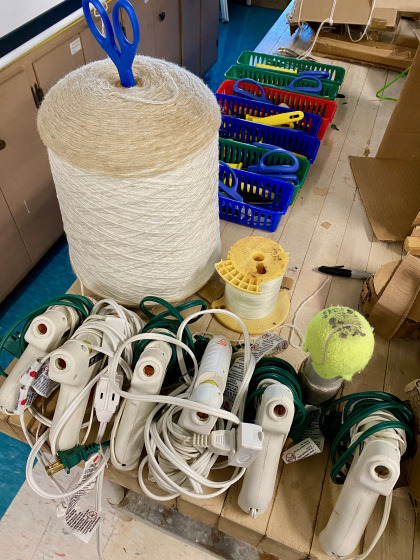
I was thorough in going over the potential hazards of the cutters and glue guns. Early on there were five or six minor cuts and about the same amount of minor burns, for which band-aids and/or cold water soothed all. Fortunately, nothing was serious, and the accidents tapered to zero after a couple of classes. Experience and confidence seemed to build resistance to injury.
Here are some photos of the cardboard artists at work:

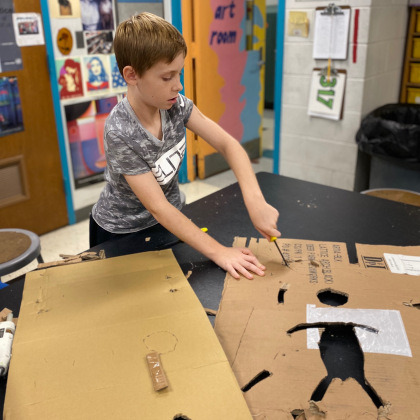
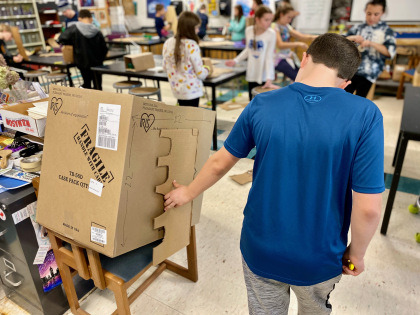
Checking the size of the cardboard part against the designated “size checker” box




Dedication!
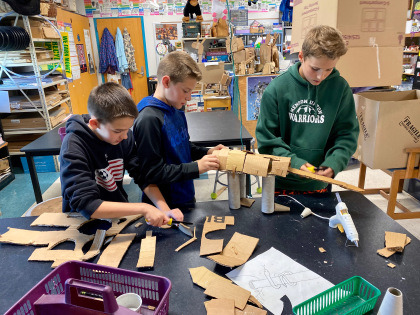
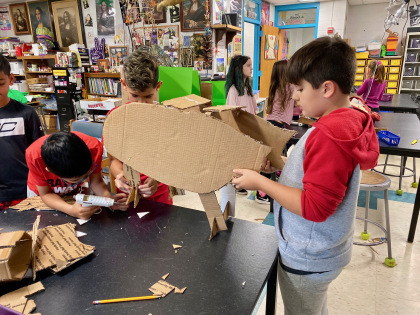



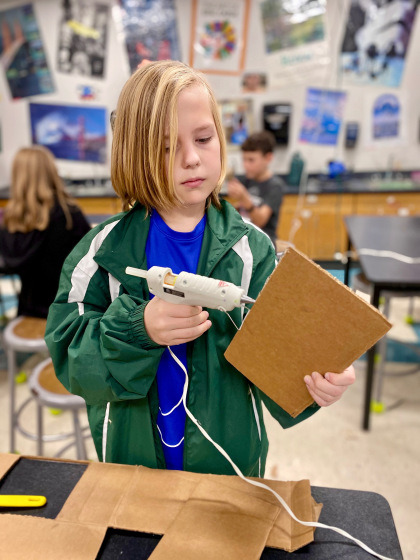

And a video of one group explaining their project as they put it (her) together:
I teach nine different classes over two days. Classes are 50 minutes long. It took most groups between five and six classes to make their cardboard creature. As groups finished, they started Phase Two – Stop Motion/Green Screen, for which I had demonstrated the apps and process around the fourth class as some groups neared completion of their build. By October 30, most groups were finished building and we took a break from building/filming so I could show them Phase Three – 3D Design (shared in a separate post); how to design for 3D using Morphi App. I was also concerned about working with hot glue and cutters while the kids were wearing costumes on Halloween; I know my own costume was too “drapey” to be messing around with hot or sharp things.
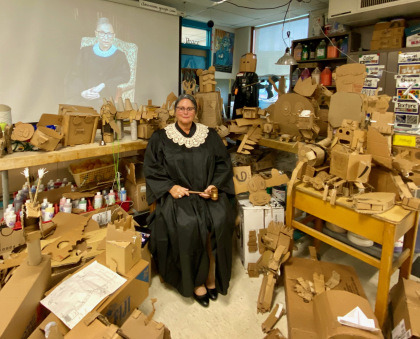
Notorious Ruth Bader Gentili with the cardboard creatures
As the Cardboard Creatures were completed, they graciously posed for photos before being herded to the school lobby for display there. As two students and I were finishing up the display near the end of the block, students were pouring into the hallways for lunch and recess. We were mobbed with excited kids looking for their creatures.
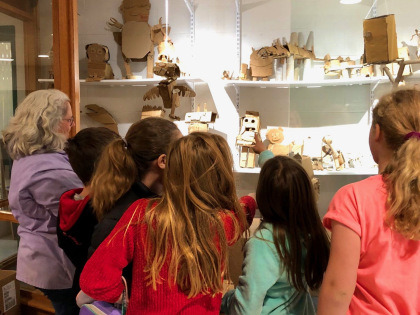
Above photo credit: Jennifer Mannion


And now (drum roll, please) here are some of the Cardboard Creatures:
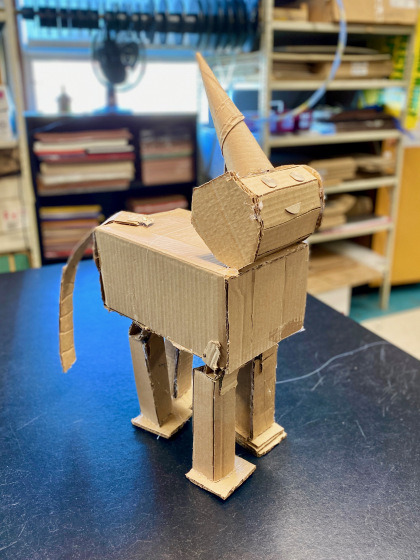
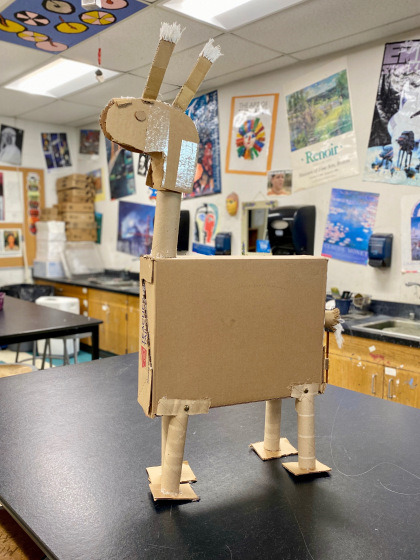

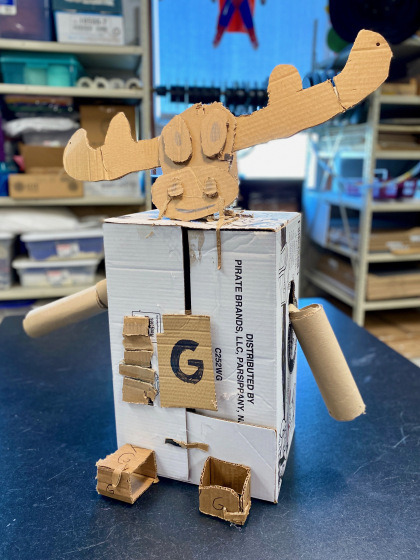


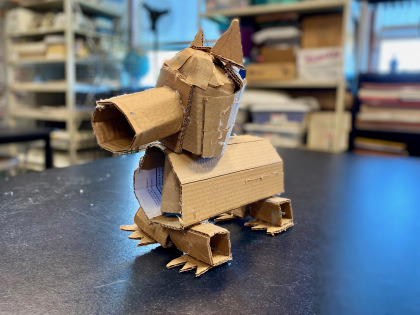
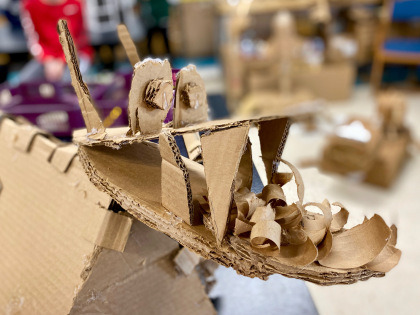
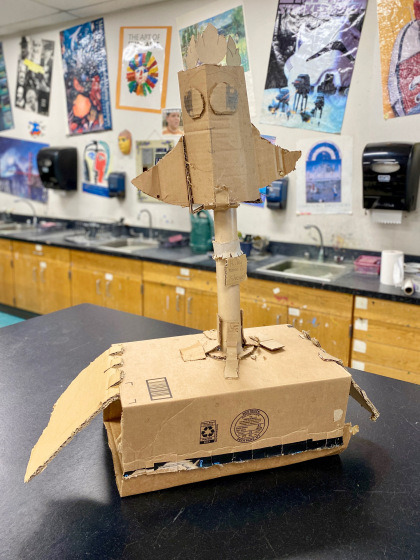

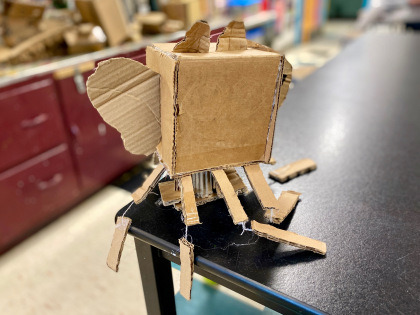
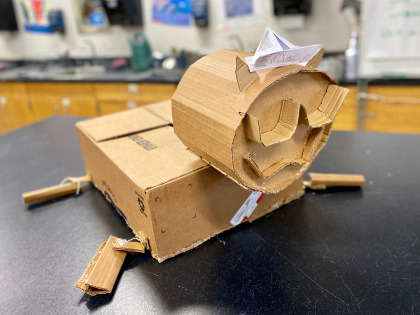


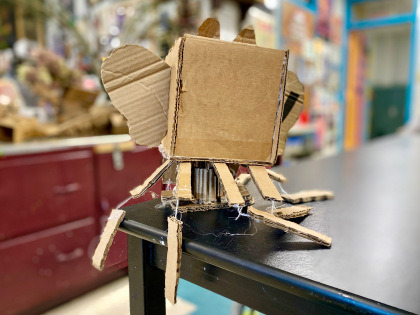
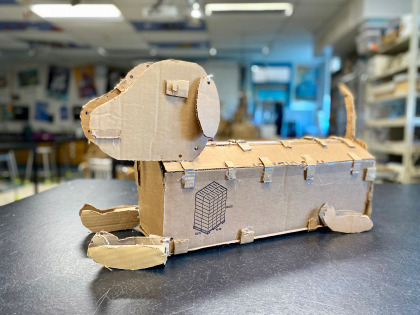
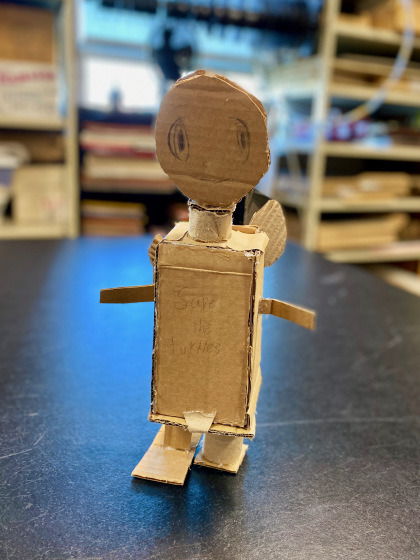
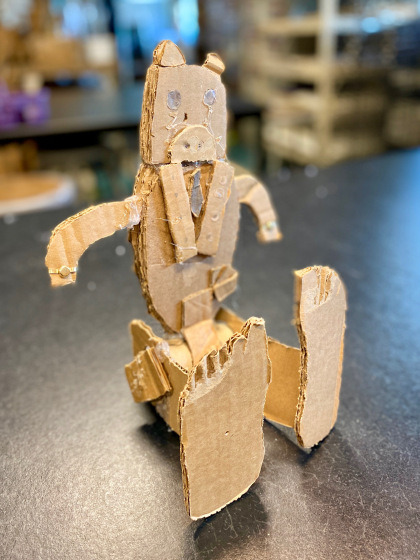


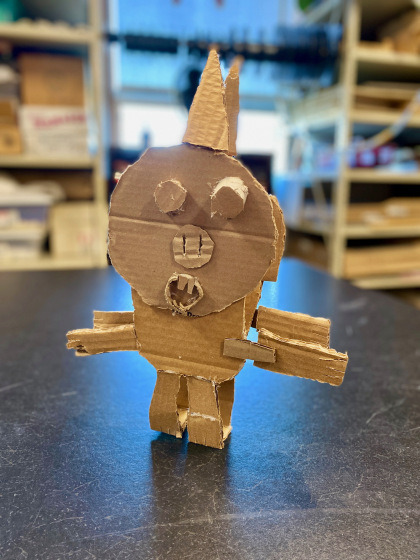

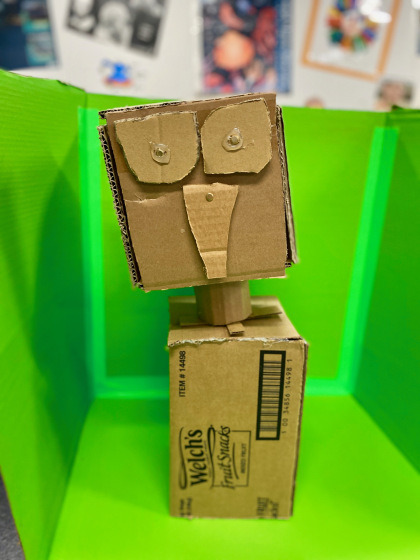
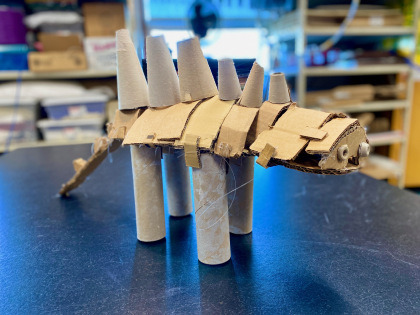


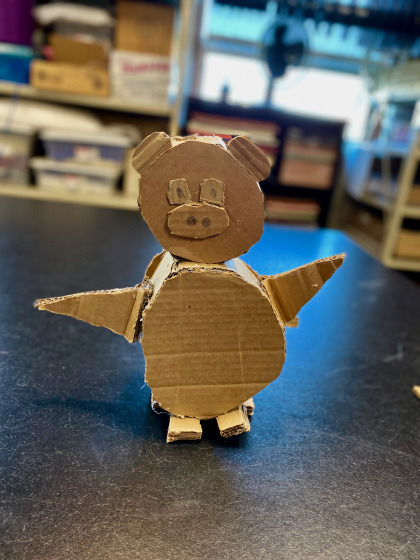

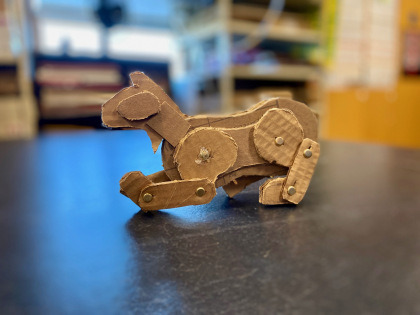

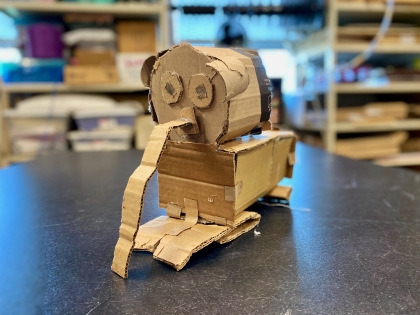



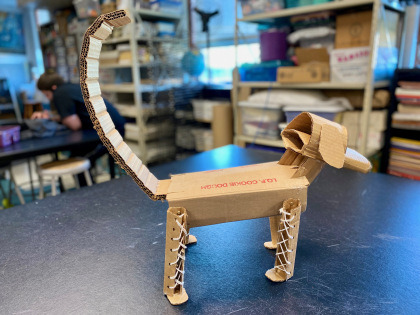
Reflection:
If I could bottle the energy the kids brought into the classroom for this project, I would apply it to some of the traditional art projects that cause some kids to check out, disengage, and mutter, “I’m not good at art”. Everyone was at home with this project. It was so different and challenging we all knew and accepted failure as part of the process. The class atmosphere was truly one of discovery, exploration, and true collaboration.
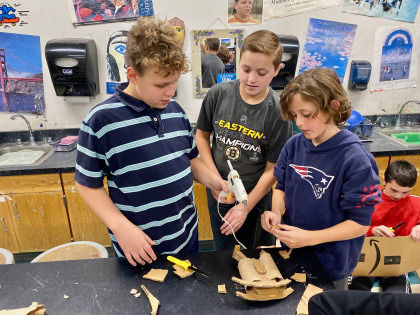
And if I had a nickel for every time a student asked, “Can we just stay here and do this all day?” I could pay for all of the glue sticks we consumed. Kidding not kidding. We went through about 200 glue sticks, necessitating a next day Amazon order in the middle of things to keep us in business. That’s completely my fault. Working groups can get away from you quickly. While you’re helping one group sort out structural issues, another group is using the glue to fasten one edge to another, which intuitively seems like it would work, but doesn’t. Cardboard is heavy and one bead of glue along the edge doesn’t support the weight. Mini-demos about this popped up in the middle of classes as I saw the mountains of glue on certain pieces. What’s the alternative? Tabs, flanges, and Lacing:
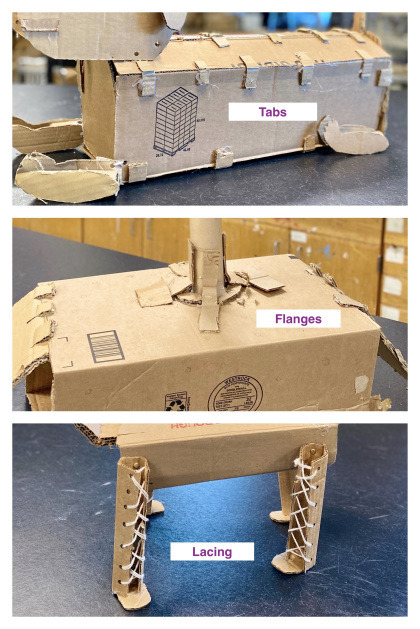
Much has been written about the important role of play in child development. This felt like play for all of us. As the teacher, my job was to facilitate the project and interactions. I would intervene with building help or smoothing group dynamics as needed. With group work, certain students struggle to maintain the balance between leading and being led. That’s where the teacher has a role in defining possible tasks within a project and helping groups to either separate out a little to make sure all are busy with defined jobs or to go all-in on one task. For instance, early on, EVERYONE wants to use the glue gun, and the teacher helps ensure that everyone has a chance.
Over the past few years I implemented group projects in November. The past few years, my fifth grade classes were engaged in the WeRMakers Product Design unit and the sixth grade classes incorporated 3D printing in the Game Makers unit. Typically we would have accomplished the important first tasks of creating a portfolio folder, making sketchbooks with covers that are also artworks, learning to photograph art and upload it to Google Classroom and our online gallery, Artsonia, as well as completing at least one additional independent art lesson before moving on to group work.
This year I shook it up a little, going from portfolio folder to sketchbook with cover artwork right into the Cardboard Creature group project. One reason is because at the end of the last school year, when I took inventory of my supplies, I also took a look at the materials I had collected through the years. I had an abundance of cardboard, including large sheets from the packaging of white boards throughout the school. As the project took shape in my mind, I reached out to my colleagues for more. It turns out Gary, a custodian at my school, is the keeper of the boxes from food deliveries, and there is a pretty good assortment in a space right outside the school kitchen. He kept us in cardboard throughout the project. Thank you, Gary!
I liked this scheduling shift a lot, as it tuns out. The group work enabled classes to get to know each other more quickly. This is especially important for my fifth grade students who come together from two different schools when they get to middle school. It also helped them to know me as a teacher earlier in the year – to learn that I value originality over sameness, exploration over duplication, and that when I get their attention, I say what I have to share and then get out of the way. This is a nice foundation to have established as we go forward into the school year.
Lastly, for me personally, I learned a lot about constructing with cardboard. I learned a lot about my students as individuals: the natural leaders, the forceful, the followers, the easy-going, the always helpful, the determined, the rays of sunshine. I enjoyed being in the art space with students, all 200 of them. No school day or cardboard creature was the same. It was fun.

Holden waves “hello”
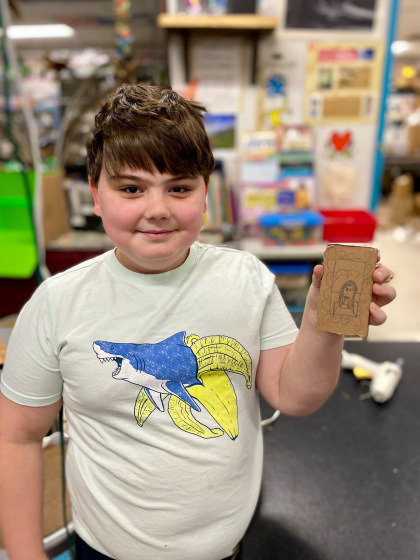
Brandon’s Mini-Mona Lisa
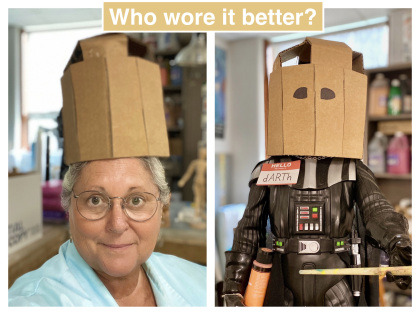
My demo for how to make a rounded form ends up as a hat/helmet, of course…
And it was magical. When I would lock up at the end of the day, I’d glance back thinking I might catch all these little creatures coming to life for the night. And when I opened the door in the morning and threw the lights on, I could feel a shift in energy, as if they had suddenly become still…the secret life of Cardboard Creatures.
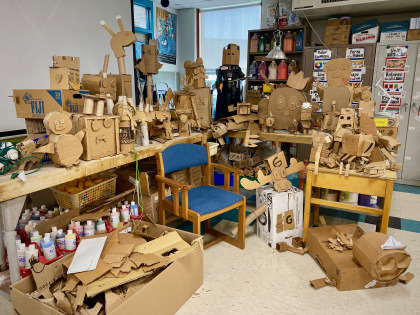
Cardboard Creature Project – Phase One – Build "The most sophisticated people I know - inside they are all children." - Jim Henson The photo above is of me and a whole bunch of cardboard on October 8, 2019 as I waited to introduce our Cardboard Creature project to an incoming class.
#ArtEducation#artsed#CainesArcade#CardboardChallenge#CardboardCreatures#collaboration#creativity#MiscoeHill#MonaLisaLivesHere#mursd#mursdvisualart#weRmakers#MakerEd
0 notes
Text
Cardboard Creatures - Phase Three - Design for 3D Printing
Cardboard Creatures – Phase Three – Design for 3D Printing
“There are 3D people stuck in a 2D world” – Katherine Douglas, Choice-Based Art Education in the Classroom (TAB), (Douglas & Jaquith, 2018)
“…especially in school art classes.” – Mona Lisa Lives Here
I am blessed with a son who participated fully in an entire childhood filled with art making experiences, from extra-curricular classes I offered at our school or other schools after school or…
View On WordPress
#3dartsed#3Dmodeling#3Dprinter#3Dprinting#arted#ArtEducation#artsed#CardboardCreatures#creativity#iPadsinart#ipadsinarteducation#ipadsintheartroom#Makerbot#MiscoeHill#MonaLisaLivesHere#mursd#mursdvisualart#SketchbookExpress#weRmakers
0 notes
Text
Cardboard Creature Project - Phase Two - Stop Motion/Green Screen
Cardboard Creature Project – Phase Two – Stop Motion/Green Screen
“My filmmaking really began with technology. It began through technology, not through telling stories, because my 8mm movie camera was the way into whatever I decided to do.” – Steven Spielberg
Starting with a quote by Steven Spielberg may seem like a lofty way to begin a post about video making by upper elementary students. To clear that potential misconception, know that this post is about the…
View On WordPress
#arted#ArtEducation#artsed#CardboardCreatures#collaboration#creativity#edtech#iPadsinart#ipadsinarteducation#ipadsintheartroom#miscoe#MiscoeHill#mursd#mursdvisualart
0 notes